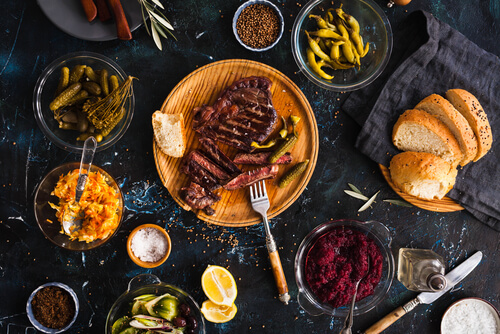



Expert Nutritionist and Future Fit Training School of Nutrition Tutor Becki Hawkins gives us some insight into new legislation that went live this week, requiring large food businesses to detail calorie (kcal) contents at the point of sale.
This move comes in an attempt by the government to level up the nation’s health and tackle soaring obesity levels.
As of 6th April 2022, many food businesses such as takeaways, restaurants and cafes are required to display calorie information of non-prepacked food and soft drinks. They have to indicate the kcals in relation to the serving size and include a statement on daily recommended calorie needs. These must be visible when a customer makes their food and drink choices, such as on a menu.
The regulations are aimed to support consumers in making informed, healthier choices. They may also encourage businesses to provide lower-calorie options for their customers.

A wide range of food businesses (with an excess of 250 employees) will have to adhere to the regulations or risk a prosecution and fine of £2500 for non-compliance via local enforcement officers. Food businesses that meet relevant criteria will all have to adhere. This ranges from food delivery businesses or foods ordered via an app to pubs, supermarkets, bakeries, events caterers, and entertainment venues such as cinemas. The government has produced much guidance for those that are unsure.
Exemptions to the new scheme include items only on a menu for 30 days or less and certain food items such as fresh unpacked single produce, e.g. an apple. Certain establishments that provide ‘in house” food, such as educational settings, hospitals/care homes, and workplace canteens, are exempt.
Nearly 2/3 of the UK adult population are overweight/obese, and 4 in 10 children leave primary school overweight or obese. The nation’s health is said to be at a crisis point. An alarming jump year on year of hospital admissions put down to obesity being the primary or secondary cause. This is now at over 1 million per year. Obesity is also a huge factor in some of the deadliest and most common “lifestyle-related disorders” pressurising our NHS: cancer, diabetes and cardiovascular disease, to name a few.
The past two years have seen considerable changes in eating habits for many linked to the Covid-19 pandemic. Restaurant eating was a distant hope for much of the two years, but that led to an astronomical rise in food delivery service uptake. “In-in” was the new “out-out”!
The food we eat out or takeaway can easily have double the calories versus the same meal we’d buy from a shop. A crucial part of this is seeing nutritional information on a food label.
Consumer research suggested ½ of consumers found kcal information on menus helpful, with just under half suggesting they value it when a menu offers a lower kcal alternative to a signature dish.

These new regulations have caused an uproar within some food and nutrition sectors. In comparison, the definition of employee numbers and also foods that may be exempt from these regulations have left other businesses confused.
There is already lobbying for a “grace period” and backlash from food businesses. They say these requirements have come at the worst possible time when many businesses are still struggling to survive post-pandemic.
From a consumer perspective, those opposing the changes were concerned that the strategy was trying to apply a “one size fits all” approach. This is conflicting with what many health professionals would say is the key to success with nutrition.
An additional area of concern comes from the one million-plus people in the UK that suffer from an eating disorder. They worry that more overt information on kcals will trigger anxiety, guilt and even more (often obsessive) focus on calories. The government feel they have responded with compassion on this by allowing menus to be provided without the kcal information if requested. However, that process could lead to people experiencing shame and fear of having declared themselves to have food issues. Some recovering individuals also feel that the ‘lack of control’ they were forced to deal with when eating out aided recovery.
Advocates for the scheme may include those who have a healthy relationship with food and who enjoy the methodical approach to food tracking. Individuals with a sports specific aim, for example, may feel this additional information helps them to retain control and stay within their targets whilst not having to pass up the social opportunities that come with eating out. Equally, this leaves questions on whether kcal information alone would be adequate to support this or should macronutrient contents also be available? If someone wanted to increase muscle mass, for example, protein intake would likely be part of their focus and interest. This is a question that Future Fit graduates may have to face regularly from clients in the coming months.

From my perspective, as a degree qualified Nutritionist with over 15 years of experience in numerous areas of the industry, calories alone are not the ultimate focus in developing a healthy diet and lifestyle. This somewhat reductionist approach has overlooked taste, cost, cultural preference, nutritional quality, nutrient density, health benefits, and satiety. A proficient nutritionist would consider all of these factors when supporting someone to eat optimally for their individual needs.
A calorie is purely a unit of energy. Where that calorie comes from and what else comes alongside it is a massive spectrum concerning how ‘healthy’ a food may be deemed for us.
The original ‘Atwater factors’ research on kcal contents (e.g., 1 gram of carbohydrate contains 4 kcal, whereas 1 gram of fat contains 9 kcal etc.) is over 100 years old. Modern science suggests flaws in this accuracy as thermogenic energy expenditure (calorie burning in the process of digesting the food) hadn’t been accounted for. This can give a window of variation of over 20%. Additionally, with stereotyped modern diets being filled with a plethora of ultra-processed foods, there is also a suggestion that some of the processing techniques alter the availability of how many calories will be absorbed by the body from that food. For example, there is evidence that we would absorb more energy from eating a set portion of refined processed carbohydrates than from the same portion of wholegrains or protein. This highlights another factor of variance in ultimately how many calories someone may obtain from a portion of food versus the kcal content on the label.

There is potentially much room for error dependent on how a business calculates the calorie contents of their dishes too. The government is set to allow a 20% leeway for this, but that alone could be significant. If someone’s overall kcal intake is 20% out of their ideal due to these discrepancies (e.g., with a target to lose weight), that could be the difference between succeeding in weight loss and maintaining their current weight. Does that mean professionals will need to set energy deficit targets at 20% more to allow for this? It all becomes very complex.
There is no doubt it’s a contentious issue, and only time will tell how it unfolds and whether it stays and grows or falls by the wayside.
Public opinion polls at this early stage haven’t shown a tremendous amount of belief that the new regulations will help tackle obesity. A survey run by Good Morning Britain received over 80% in votes of no confidence.
Meanwhile, the government is now talking about encouraging smaller businesses to adopt calorie labelling too and restricting the promotion of less healthy foods online, in-store, and on TV. We’re likely to see a watershed on less healthy food adverts before 9 pm.
The takeaway (pun intended! 😊) message from me would be to try and see some positives in these new guidelines where possible. Use the additional information to increase awareness and instil a feeling of empowerment, enabling you to make a more informed choice. Whilst also having a giggle at some of the shockers that emerge!
However, and this is vital….
Don’t get hung up on calorie contents alone. Try to learn about your individual nutritional needs and focus on the nutritional quality, nutrient density and health-giving properties of your diet as a whole. There are very few “bad foods” in this world, but many people have poor eating habits.